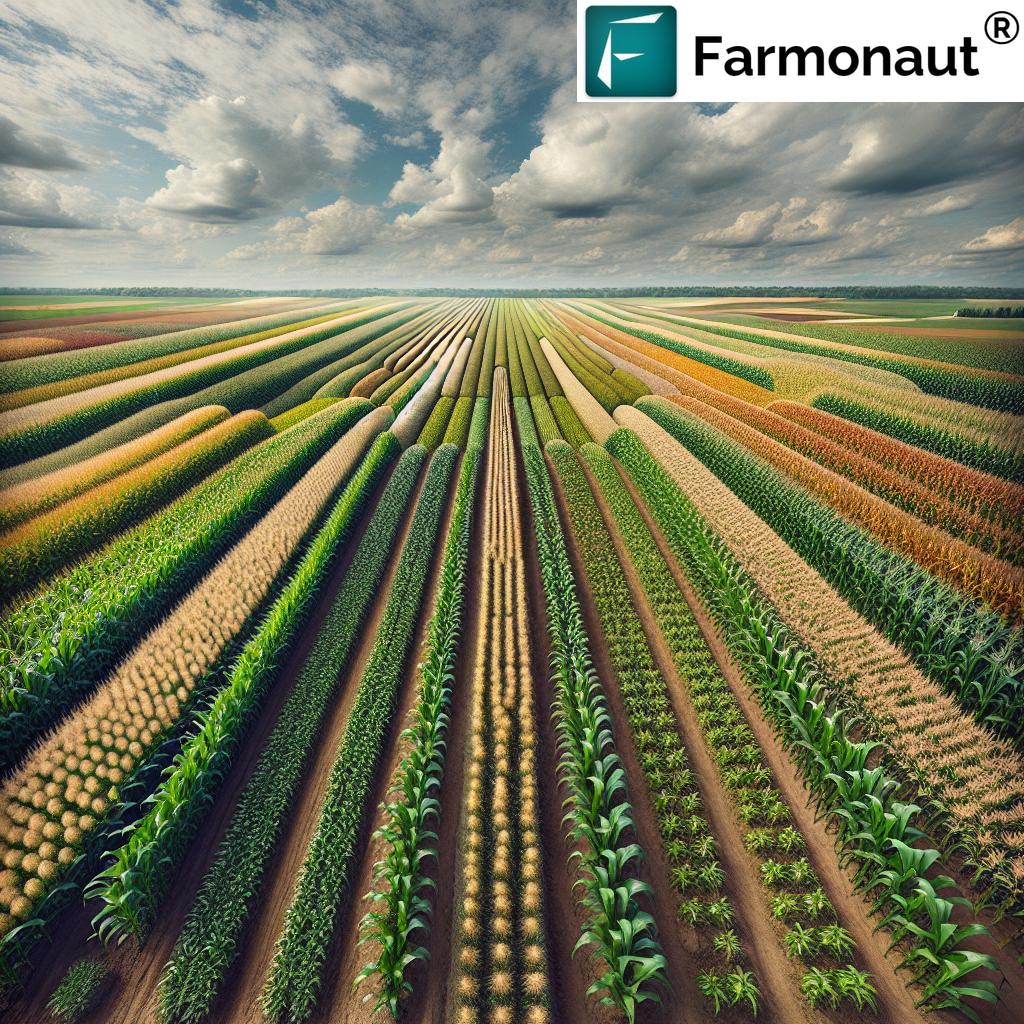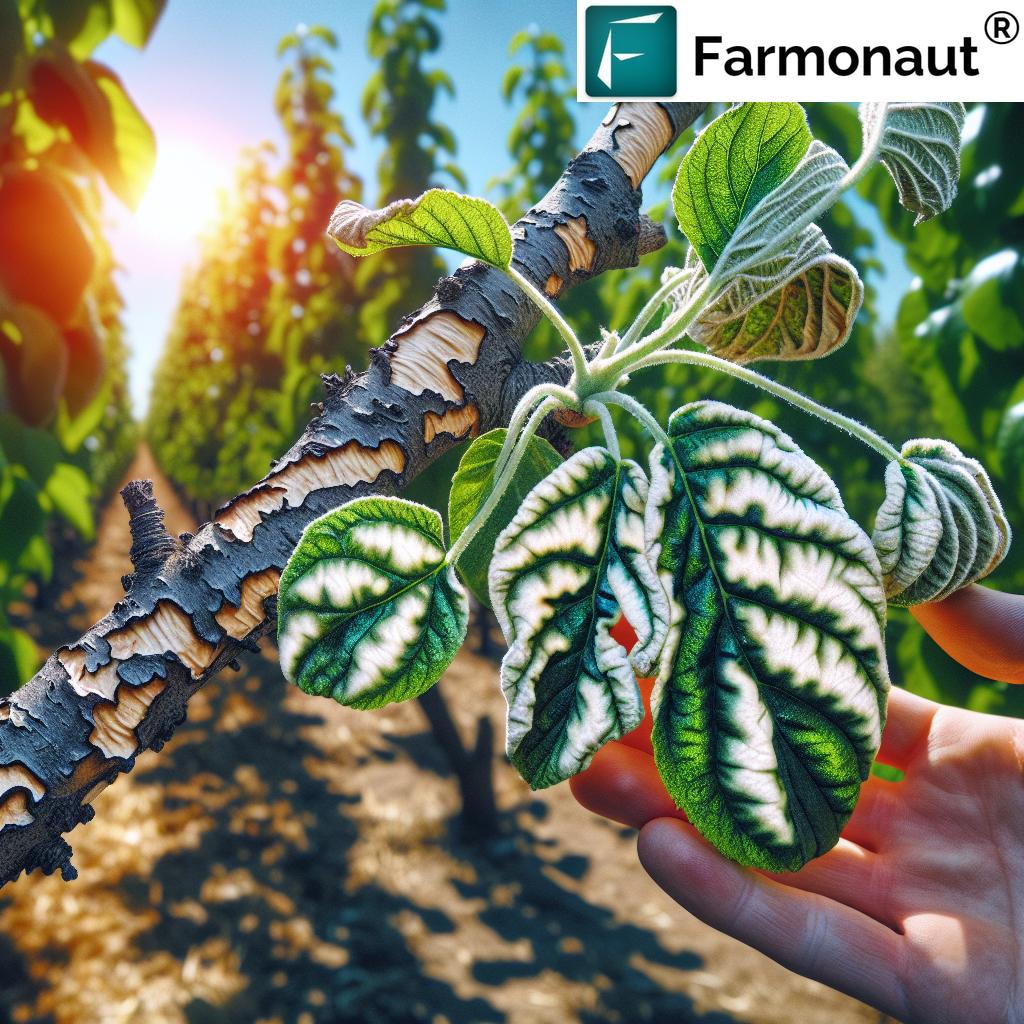Planting Cover: 7 Crimson Clover & No Till Methods
Table of Contents
- Introduction: Why Planting Cover Crops is Transforming Agriculture
- Understanding Cover Crops and Their Importance
- Crimson Clover Planting: The Nitrogen Powerhouse
- No Till Planting: Revolutionizing Soil Health & Sustainability
- Integrating Cover Planting and No Till Methods for 2025 and Beyond
- Comparative Methods Table: Cover Crop Strategies for Sustainability & Productivity
- Mechanization & Innovation: Optimizing Cover Crop Planting
- Benefits Beyond Soil Health: Ecosystem, Economics & Regulation
- Farmonaut’s Role: Advanced Satellite Insights for Planting Cover
- Looking Ahead: Future-Proof Practices for 2026 and Beyond
- Frequently Asked Questions
Introduction: Why Planting Cover Crops is Transforming Agriculture
The practice of planting cover crops is revolutionizing modern agriculture by simultaneously promoting soil health, boosting crop productivity, and enabling sustainable farming systems. As we move further into 2025 and toward 2026, worldwide focus on climate-smart agriculture, enhanced resource management, and environmental stewardship has accelerated the adoption of new planting cover techniques.
Among these, innovative combinations such as crimson clover planting (Trifolium incarnatum) with advanced no till planting methods are gaining significant traction among farmers aiming to increase yields while safeguarding natural resources. Whether in rotations with wheat, corn, or interplanted in rice systems, these integrated strategies allow us to balance productivity with resilience—a critical factor for agriculture in the face of climate variability and regulatory pressures.
This comprehensive guide explores the essence of planting cover crops, with an emphasis on crimson clover and no till strategies. We’ll also dive into real-world techniques, mechanization trends, comparative sustainable methods, and how satellite-based solutions—like those offered by Farmonaut—can optimize every stage of the cover cropping process.
Understanding Cover Crops and Their Importance
At its core, planting cover means growing plants primarily to protect and improve soil—rather than for direct harvest. These crops are sown during off-seasons or alongside main crops, serving multiple purposes:
- Preventing soil erosion from wind and water
- Enhancing organic matter content in the soil via biomass residues
- Fixing atmospheric nitrogen (especially with legumes like crimson clover)
- Suppressing weeds through competition and allelopathy
- Improving water retention and soil structure
This holistic benefit supports long-term fertility, reduces our dependency on synthetic fertilizers, and actively fosters biodiversity—key priorities for sustainable agriculture.
Cover crops include species like rye, vetch, mustards, and—especially for nitrogen fixation—Trifolium incarnatum (crimson clover). Choosing the right cover crop, timing, and planting technique is essential in optimizing outcomes for each unique climate and cropping system.
Key Advantages of Planting Cover Crops:
- Soil Protection: A dense green cover on bare ground prevents erosive loss of valuable topsoil layers, particularly during off-seasons or between main crops.
- Organic Matter Enhancement: Crop residues and root biomass from cover planting increase organic carbon and nutrient reserves in the soil profile.
- Biological Activity: Cover cropping enhances soil microbial activity, driving essential soil processes like nutrient cycling and disease suppression.
- Water Regulation: Cover crops improve water infiltration and retention, reducing surface runoff and supporting drought resilience in dry periods.
- Nutrient Cycling and Nitrogen Fixation: Legume covers, especially crimson clover, actively convert atmospheric nitrogen into plant-available forms, minimizing the need for synthetic supplements.
With global shifts toward climate-responsible farming and stricter environmental regulations, these combined ecosystem services make planting cover crops an indispensable tool for farm management in 2025 and the years ahead.
Crimson Clover Planting: The Nitrogen Powerhouse
Among cover crop species, crimson clover (Trifolium incarnatum) stands out for its rapid establishment, high nitrogen-fixing ability, and exceptional ground coverage. Especially popular in temperate regions and in rotations with cereals like corn and wheat, this legume delivers both agronomic and environmental rewards.
Crimson clover is typically sown post-harvest (late summer to early autumn) or in early spring depending on regional cycles. Its vigorous growth allows it to outcompete weeds, provide a dense biomass layer, and substantially increase soil nitrogen content.
- Valued Traits: Rapid germination, adaptability to cooler climates, suitability for intercropping, and a shallow root system that enhances upper soil fertility.
- Nitrogen Fixation: Up to 100 kg N/ha with mature growth, reducing input costs for the subsequent main crop and supporting more sustainable fertilizer management.
- Biodiversity: Crimson clover flowers attract a range of beneficial pollinators and natural antagonists, promoting ecological balance on farms.
Crimson clover planting methods can include broadcast seeding, drilling, or even aerial application, depending on acreage and intended system integration. For optimal results, target a seeding rate of 15-20 kg/ha on well-prepared soil or more if sowing via broadcasting into standing crops.
Benefits of Crimson Clover in Sustainable Rotations
- Reduces reliance on synthetic nitrogen fertilizers, cutting input costs and minimizing environmental impact
- Suppression of early-season weeds due to rapid canopy closure
- Improves subsequent crop yields by enhancing nutrient availability and soil structure
- Multipurpose use: Suitable for forage, green manure, living mulch, or pollinator plots
No Till Planting: Revolutionizing Soil Health & Sustainability
The no till planting technique has rapidly moved from an experimental method to a mainstream sustainable agriculture strategy. Here, seeds are sown directly into undisturbed soil—often into crop residue or existing cover vegetation—minimizing soil disturbance, reducing erosion, and preserving organic matter.
No-till methods are increasingly adopted in combination with cover crop planting (such as crimson clover), creating a synergy that amplifies both soil health and resource efficiency.
- Minimizes compaction and long-term damage to soil structure, thus optimizing crop rooting, water infiltration, and microbial activity
- Lowers labor, fuel costs, and greenhouse gas emissions compared to intensive tillage systems
- Reduces risk of soil moisture loss in fluctuating weather—critical for climate-adaptive farming
- Facilitates integration of mechanized tools like seed drills and rice planting machines for large-scale operations
- Encourages natural weed suppression through mulch effect of surface residues
Key takeaway: No till planting is not only beneficial for the soil—it’s essential for modern, scalable, environmentally-responsible agriculture in 2025 and beyond.
For more on real-time soil condition insights that can inform your no till cover crop strategies, check out our Carbon Footprinting Solution which enables farms to track soil health metrics and carbon sequestration using advanced satellite and AI data.
How No Till Planting Works with Cover Crops:
- Seeds are placed directly into standing residue or living cover (like crimson clover) after chemical or mechanical termination.
- Specialized no-till planters or drills create minimal soil disturbance, maintaining crucial soil structure while ensuring accurate placement.
- Residues serve as mulch, further suppressing weeds and moderating temperature and moisture loss.
Combination practices—such as no till rice planting machine integration for paddy fields—expand these benefits into diverse cropping systems and regions:
- No till planting is critical in satellite-monitored rice fields (Asia, South America) for efficient water management, reduced run-off, and erosion control.
- Mechanization lets large and smallholder farmers scale up cover crop utilization with consistency and precision.
For AI-powered planting recommendations based on region-specific satellite data, explore Farmonaut’s Crop Plantation Forest Advisory, delivering actionable strategies directly to your devices.
Integrating Cover Planting and No Till Methods for 2025 and Beyond
The integration of crimson clover planting and no till methods leads to a multiplier effect for soil health, yield resilience, and overall sustainability—particularly critical for future-focused farming as we approach 2026.
Why integrate? Because the objectives and benefits of both strategies align and reinforce each other:
- Diversified Soil Structure Improvement: Cover residues shield and enrich topsoil, while minimal disturbance preserves natural aggregation and porosity.
- Enhanced Water Cycling: Living and dead plant material improves infiltration rates and reduces both run-off and evaporation loss.
- Decreased Inputs and Costs: Planting cover crops like crimson clover naturally supplies additional nitrogen, while no till planting reduces both herbicide and fertilizer needs over time.
- Climate Mitigation: These methods sequester more carbon, lower emissions, and make cropping systems more resilient to weather extremes.
- Ecosystem & Regulatory Compliance: Enhanced biodiversity, reduced nutrient leakage, and less land degradation meet and surpass environmental expectations.
Employing these methods in tandem is increasingly considered best practice for innovative, sustainable agriculture systems worldwide. Real-time data from platforms like Farmonaut’s satellite monitoring can help pinpoint the optimal planting windows and ensure continuous monitoring for maximum benefit.
Ready to monitor your field’s health, optimize your practices, and ensure regulatory compliance? Access our Large Scale Farm Management tool that delivers scalable satellite-based insights for sustainable farming operations.
Comparative Methods Table: Cover Crop Strategies for Sustainability & Productivity
| Cover Crop Method | Estimated Soil Health Improvement (%) | Weed Suppression (Estimated %) | Required Input Cost (USD/acre) | Typical Sowing Time (Months) | Erosion Control Effectiveness (Estimated %) | Compatible Climate Zones |
|---|---|---|---|---|---|---|
| Crimson Clover (Seeding-Only) | 30-40 | 50-70 | $30–$55 | August–October / February–April | 50–70 | Temperate, Subtropical |
| Crimson Clover + No Till | 45–60 | 65–80 | $40–$60 | Sept–Nov (post-harvest) | 70–90 | Temperate, Subtropical, Moist Tropics |
| Hairy Vetch Mix | 30–50 | 60–75 | $35–$75 | October–December | 65–85 | Temperate, Mediterranean |
| Rye-Clover Blend | 35–55 | 70–90 | $40–$65 | September–November | 80–95 | Broad (Temperate, Subtropical, Semi-Arid) |
Mechanization & Innovation: Optimizing Cover Crop Planting
Mechanized planting techniques are critical in scaling up cover cropping systems while ensuring uniform establishment, efficient input management, and alignment with no till practices. Modern rice planting machines, high-accuracy seed drills, and inter-row cover planters are reshaping how farmers adopt and manage cover crops in both cereal rotations and paddy fields.
- Rice Planting Machines: Accelerate no till cover crop establishment in waterlogged or minimally-disturbed soils; enhance consistency and maximize productivity in paddy rice systems, especially in regions across Asia and South America.
- Precision Interseeders: Allow crimson clover to be sown between standing main crops, optimizing land use, time, and labor during critical seasonal windows.
- Aerial & Drone Seeding: Innovative for large or uneven terrains, these methods expand access, reduce labor and reach broadacre fields with minimal soil disruption.
Mechanization helps overcome barriers in input cost and labor—making sustainable cover crop adoption accessible to smallholders and expansive enterprises alike. Monitoring performance at scale is equally important, which is where platforms such as Farmonaut’s Fleet Management Tools add value, optimizing machinery use and minimizing resource wastage across diversified farming operations.
Technological Integration for Maximum Impact
AI-driven advisory systems and advanced resource management platforms now enable satellite-guided planting windows, variety selection, and real-time monitoring for any planting cover strategy. These technologies directly improve efficiency, ensure compliance, and help adapt practices to ever-changing weather and climate impacts—critical factors for 2026 and beyond.
For those seeking to seamlessly integrate field operations, resource monitoring, and regulatory-compliant crop management, Farmonaut’s Traceability Solution offers blockchain-powered supply chain tracking, improving transparency for producers and buyers alike.
Benefits Beyond Soil Health: Ecosystem, Economics & Regulation
Planting cover crops delivers tangible benefits well beyond immediate soil health and productivity. In the context of climate adaptation, water management, and evolving environmental policy enforcement, these methods form a strong foundation for future-proof, responsible agriculture.
- Ecosystem Resilience: Enhanced microbe biodiversity and disease suppression—thanks to crop diversity and reduced chemical dependency—break pest and pathogen cycles.
- Economic Value: By reducing input costs (fertilizers, herbicides, labor), optimizing water use, and buffering against yield variability, cover crop planting strategies offer real financial security for farmers.
- Regulatory Compliance: With increased focus on carbon accounting, runoff control, and nutrient management, no till planting combined with crimson clover cover simplifies reporting and meets sustainability standards.
- Climate Smart Readiness: Carbon storage, improved rainfall efficiency, and temperature moderation help crops and soil systems adapt to extreme weather and long-term climate shifts.
Explore how our Crop Loan & Insurance Solutions support transparent verification of cover cropping practices, enabling access to preferential rates for farms practicing regenerative agriculture.
For powerful integration and scalable insights, developers and enterprises can access the Farmonaut Satellite API and view detailed API Developer Docs. Get seamless weather, soil, and crop health data to plug into your custom applications and management workflows.
Farmonaut’s Role: Advanced Satellite Insights for Planting Cover
As a satellite technology leader, we at Farmonaut empower modern agriculture by delivering affordable, actionable, and scalable insights—perfectly suited for integrating planting cover crop methods like crimson clover and no till planting.
- Satellite-Based Monitoring: Monitor vegetation health (NDVI), soil organic matter, water stress, and crop growth across fields—no matter their size or location.
- AI and Jeevn Advisory: Receive recommendations on optimal planting windows, cover crop selection, and risk mitigation via regular app notifications and reports.
- Blockchain Traceability: Showcase your sustainable practices and build trust with downstream buyers by verifying cover crop integration and soil stewardship.
- Environmental Impact Tracking: Quantify carbon footprint and demonstrate compliance with climate-smart policy—especially vital for farm certification and premium market access.
- Fleet & Resource Management: Increase machinery ROI, minimize downtime, and coordinate multi-field planting efficiently.
For anyone ready to take their planting cover strategy to the next level in 2026 and beyond, our subscription model ensures full accessibility via Android, iOS, web, or API—fitting your operational scale and budget.
Looking Ahead: Future-Proof Practices for 2026 and Beyond
Planting cover crops with advanced no till methods and optimized mechanization is set to remain the gold standard for sustainable agriculture in 2026 and well beyond. Growing global focus on soil regeneration, carbon sequestration, and resource efficiency will continue accelerating adoption of integrated cover crop systems.
This future is supported by:
- Continuous innovations in seed technology, machinery, and remote sensing tools
- Expanding access to satellite-powered insights for both smallholder and large-scale operations
- Policy incentives, environmental stewardship requirements, and climate resilience demand
- Stronger integration of AI-driven analyses and decentralized data verification via blockchain
At Farmonaut, we are committed to enabling smarter decision-making and improved performance for farming systems that embrace planting cover, crimson clover, and sustainable no till planting methods. As technology and data converge, agriculture can look forward to a resilient, profitable, and environmentally responsible new era.
FAQ: Planting Cover, Crimson Clover Planting & No Till Methods
Q1. What is the best time for planting crimson clover as a cover crop?
Crimson clover is best sown in late summer to early fall after cereal grain harvests, or in early spring for vegetable and specialty rotations. It requires mild soil temperatures (8–15°C/46–59°F) for rapid establishment.
Q2. Do I need special equipment for no till planting with cover crops?
No till planting can be done with specialized planters or drills that open narrow furrows with minimal soil disturbance. For large fields or paddy, mechanized seeders or rice planting machines are often used.
Q3. How does crimson clover improve soil nitrogen content?
Crimson clover forms symbiotic relationships with root bacteria, which “fix” atmospheric nitrogen and make it available to subsequent crops. This can contribute up to 100 kg N/ha of plant-usable nitrogen.
Q4. What are the main environmental benefits of integrating cover crops and no till?
Key environmental benefits include reduced soil erosion, increased carbon sequestration, improved water infiltration, decreased fertilizer runoff, and enhanced on-farm biodiversity.
Q5. Can satellite technology like Farmonaut help manage cover crops?
Yes. Farmonaut’s satellite-powered platform offers real-time monitoring of soil health, crop progress, and helps optimize planting windows and applications for cover crop systems.













